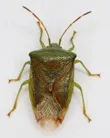
Harmful Effects of Acanthosoma denticaudum
A species of Acanthosoma
Acanthosoma denticaudum poses risks to certain plants by sucking fluids from leaves, stems, and fruits, causing tissue damage, wilting, and reduced vigor, which may affect photosynthesis and fruit production.
What Type of Pest Is Acanthosoma denticaudum?









AI entomologist in your pocket
Scan QR code to download

